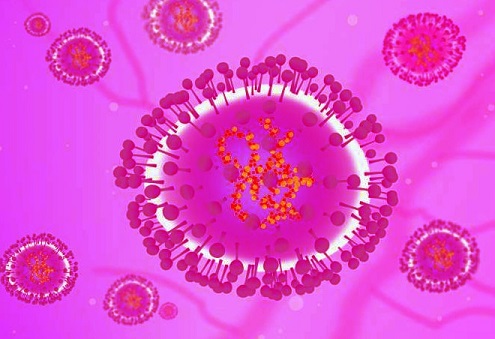Human Metapneumovirus (HMPV) Alters Actin Cytoskeleton of Host Cells to Enhance Direct Cell-to-Cell Spread
Nikhil Prasad Fact checked by:Thailand Medical News Team Jan 03, 2025 11 months, 3 days, 21 hours, 2 minutes ago
Medical News: Human Metapneumovirus (HMPV), a key respiratory pathogen, has been thrust into the spotlight due to groundbreaking research unveiling its unique methods of infection. This virus, which primarily causes acute respiratory illnesses, has long puzzled scientists. Now, researchers from the University of Kentucky, National Institute of Allergy and Infectious Diseases (NIAID), and the University of California, San Francisco have made a significant discovery. They reveal how HMPV cleverly manipulates the actin cytoskeleton of host cells to facilitate its spread directly from one cell to another, bypassing traditional mechanisms of viral dissemination. This
Medical News report delves into the study, explaining the implications for those without a medical background.
 Human Metapneumovirus (HMPV) Alters Actin Cytoskeleton of Host Cells to Enhance
Human Metapneumovirus (HMPV) Alters Actin Cytoskeleton of Host Cells to Enhance
Direct Cell-to-Cell Spread
What Makes HMPV Special?
HMPV is part of the Paramyxoviridae family, which includes other respiratory viruses like Respiratory Syncytial Virus (RSV) and measles. Unlike some of its relatives, HMPV lacks available vaccines or specific antiviral treatments, leaving healthcare providers with limited options beyond supportive care. The virus is known for its ability to cause symptoms ranging from mild cold-like effects to severe pneumonia in vulnerable populations such as young children, the elderly, and immunocompromised individuals.
Scientists have long understood that viruses use host cell machinery to replicate and spread. However, the intricacies of how HMPV achieves this remained elusive until now. This new research sheds light on how the virus reshapes host cell structures, enhancing its ability to infect neighboring cells. Such findings hold promise for developing novel therapeutic strategies.
Actin Cytoskeleton: The Target of HMPV
At the heart of the study lies the actin cytoskeleton, a dynamic network of protein filaments essential for maintaining cell shape, enabling movement, and mediating intracellular transport. Researchers demonstrated that HMPV induces dramatic changes to this structure, forming extensive networks of branched filaments and intercellular extensions. These structures allow the virus to travel directly between cells without exposing itself to immune defenses.
In laboratory experiments using human bronchial airway cells, the team observed the formation of intricate intercellular connections. These extensions serve as viral highways, enabling the direct transfer of HMPV components, including its genetic material and proteins, from infected to uninfected cells. This process circumvents the need for free viral particles, which are more vulnerable to neutralizing antibodies.
Key Findings of the Study
The research team employed various techniques, including immunofluorescence microscopy and proximity ligation assays, to uncover these mechanisms. Key findings include:
-Dependence on Actin Polymerization: When ce
lls were treated with drugs that disrupt actin dynamics, such as cytochalasin D, the formation of intercellular extensions and viral spread significantly decreased.
-Role of Viral Proteins: The HMPV phosphoprotein (P) was found to co-localize with actin and play a pivotal role in forming membrane extensions. This protein’s activity is a novel discovery, as previous studies of paramyxoviruses focused on other structural proteins like the matrix (M) protein.
-Involvement of Rho GTPases: Cellular signaling pathways involving Rho GTPases, such as Cdc42 and Rac1, were crucial for actin remodeling and the formation of these viral structures. Inhibition of these pathways curtailed viral spread.
Direct Cell-to-Cell Spread: Even under conditions where cell-free viral particles were neutralized by antibodies or when host cells lacked heparan sulfate (a known receptor for HMPV), the virus efficiently spread through intercellular extensions.
Implications for Public Health
These findings have profound implications for understanding viral pathogenesis and developing interventions. By targeting the molecular pathways that HMPV exploits, researchers may develop therapies that inhibit its ability to reorganize the actin cytoskeleton. Such treatments could limit the virus’s ability to spread within the respiratory tract, potentially reducing disease severity and transmission.
Moreover, this study underscores the importance of host-pathogen interactions. The ability of HMPV to manipulate cellular structures highlights the sophistication of viral evolution. It also provides a cautionary reminder of the challenges posed by respiratory viruses in general, especially in the absence of effective vaccines.
Conclusions and Future Directions
The study conclusively demonstrates that HMPV employs a unique mechanism to enhance its spread by reorganizing the actin cytoskeleton of host cells. This mechanism not only aids in viral dissemination but also helps the virus evade immune detection. By leveraging direct cell-to-cell spread, HMPV avoids exposure to neutralizing antibodies and receptor barriers.
Future research should focus on identifying small molecules or biologics that can specifically inhibit the interaction between viral proteins and the actin cytoskeleton. Additionally, understanding whether similar mechanisms are used by other respiratory viruses could pave the way for broad-spectrum antiviral therapies.
The study findings were published in the peer-reviewed journal: PLOS Pathogens.
https://journals.plos.org/plospathogens/article?id=10.1371/journal.ppat.1005922
For the latest HMPV News, keep on logging to Thailand
Medical News.
Read Also:
https://www.thailandmedical.news/news/doctors-warn-that-hmpv-can-trigger-deaths-in-children-with-covid-19
https://www.thailandmedical.news/news/hmpv-is-adapt-at-viral-persistence-hiding-in-lung-neural-fibers-and-reactivated-by-glucocorticoid-treatments
https://www.thailandmedical.news/news/online-media-claim-that-china-has-declared-a-health-emergency-and-that-hospitals-and-crematoriums-are-overflowing-is-it-true
https://www.thailandmedical.news/articles/hmpv-human-metapneumovirus
